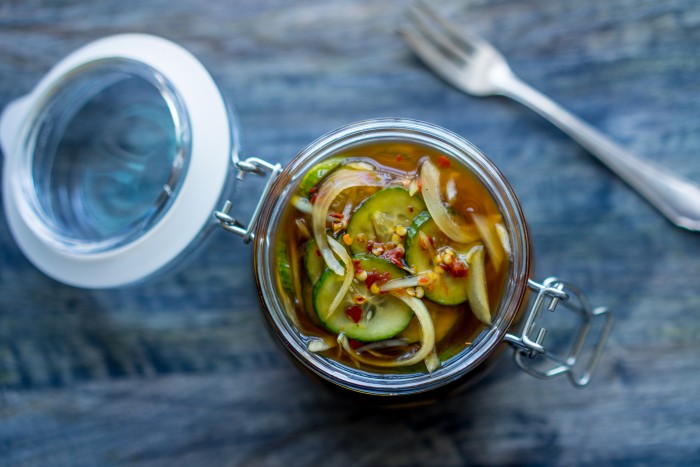My mother never told me to eat my greens, because she never made them. I’m not sure if she didn’t like greens or just wasn’t sure what to do with them (most likely), but spinach, collards, kale and other hearty cooking greens didn’t join my plate until I grew up and discovered I love them.
That’s why I'm always look for ways to add greens to the menu. Of course, they’re good for you–rich in a host of vitamins (especially A and C), minerals (like iron and manganese) and phytonutrients. Even better, hearty greens are at their peak right now, and their earthy flavor is a perfect fit for winter meals … right up to the cusp of spring.
Select greens that have fresh, crisp, unblemished leaves; they’ll keep in the fridge for up to five days. Their leaves tend to trap dirt and grit, so you’ll want to wash them thoroughly. I like to zip the leaves from the stems (check out Lia’s speedy technique to “Zip Some Greens“), toss them in a big salad spinner, which I fill with water and dunk the leaves several times (this allows any grit to settle at the bottom) before spinning them dry. Then I tear or chop the leaves as needed.
Though you can use most greens interchangeably, their flavor ranges from mild to spicy. For substitution guidelines, visit The Cook’s Thesaurus. Here’s a rundown of a few of our faves:
- Beet greens: If you buy a bunch of beets with the leaves still attached, don’t throw those delicious, earthy-tasting leaves away. Instead, simply saute them, much as you would spinach. Or try them boiled in Mama Kourtesi’s Beet and Green Salad.
- Broccoli rabe has a pungent, bitter quality that Italian cooks adore. A bit of olive oil and salt helps tame the bitterness. Try it steamed, broiled or braised. In Lia’s Orecchiette with Broccoli Rabe and Sausage, a pot of boiling water does double-duty to cook the pasta and rabe at the same time.
- The Italians also love bitter chicory, which they boil and serve with a white sauce or puree with a touch of cream.
- I’ve come to love the mild flavor of collard greens, which generally benefit from long braising. But if you slice them super-thin, as we do with our Quick Collards below, you can cook them quickly with a combo of sauteing and braising.
- Kale is a part of the cabbage family, so it (not surprisingly) has a cabbage-y quality. Discard the center stem and treat the curly leaves much the way you would spinach. Frilly-leaf kale is the most common variety, but you’ll find other types (lacinato, for example) at farmers’ markets and gourmet stores. Try it in our Crispy Kale Chips or White Bean and Kale Ragout with Turnips and Sausage.
- For a spicy, peppery bite, try mustard greens, which do well braised with bacon. For an even more assertive selection, try turnip greens (yep, you can use turnip greens in place of the sausage in the ragout).
- Spinach may well be the most popular variety. Large, mature leaves should be cooked (steamed, boiled, braised), while baby spinach does fine with a quick saute or even raw in a salad. Make a batch of Cheryl’s Stir-Fried Greens with Cremini Mushrooms and Soba.
- With bright green leaves and colorful stems in a variety of hues, from magenta to orange-gold, Swiss chard is another favorite in the NOURISH Evolution kitchens. It’s hearty enough to braise, yet tender enough to saute. Try it in our Spicy Sauteed Rainbow Chard with Golden Raisins, which incorporates those pretty stems.
This is by no means a complete list. If you visit an ethnic market or farmers’ market, you’ll find many other varieties. Just ask the merchant for tips to cook them. The broader your repertoire of greens, the more often you’re likely to eat them!















